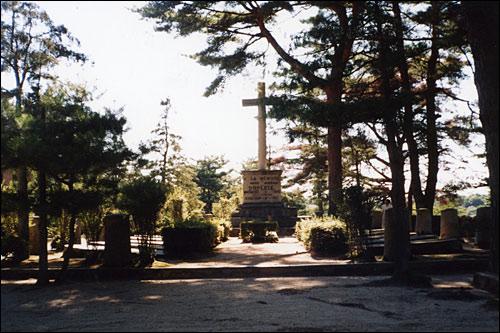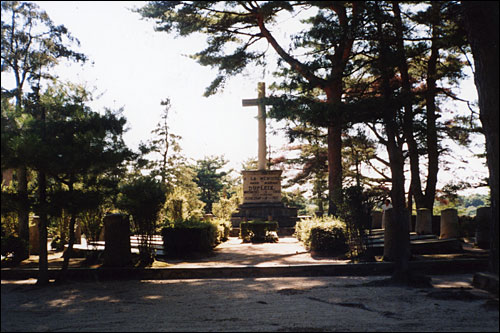The Shuhogahara French Military Cemetery in Kobe

The Shuhogahara French Military Cemetery.
Source: French Embassy in Tokyo
The Shuhogahara French Military Cemetery in Kobe, in Japan, groups together the bodies of 40 soldiers who fell during the expedition of 1864.
The Shuhogahara French Military Cemetery in Kobe, in Japan, groups together the bodies of 40 soldiers who fell during the expedition of 1864. The Shuhogahara necropolis in Kobé is managed by services of the French consulate general in Osaka-Kobé. Since 1868, it has held the remains of 40 members of the 1864 expeditionary corps.
From the middle of the 19th century onwards, Japan, following on from China, was made to agree to open her inland seas in order to seal trade relations with the United States, Russia, the United Kingdom, Prussia, the Netherlands, Portugal and France. These newcomers to the Japanese market caused anxiety for the population, strengthening the nationalist party against the Shogunate regime. Acts of hostility manifested themselves during the month of September 1862 with the assassination of the British negotiator Richardson. On 25 June 1863, the Shôshû coastal batteries fired on the "Pembroke", an American ship, as it crossed the straits of Shimonoseki. On 7 July, a French navy dispatch boat, the "Kien-chan", suffered the same attacks. On 20 July 1863, Admiral Jaurès, in command of the "Tancrède" and the "Sémiramis" bombarded the batteries in the straits of Shimonoseki, landing a regiment of 250 men and setting fire to two villages. On 15 August, Admiral Kuper had the Kogashima bombed by the Royal Navy in retaliation for the assassination of Richardson. However, Japan's inland seas remained a no-go area for westerners. Negotiations opened in Paris in the month of August, with Japan agreeing on the 20th to open the strait of Shimonoseki. However, the Shogun rescinded five days later. On The 30th September, the Shogun ordered the expulsion of all foreigners and the closure of the straits of Yokohama. The western powers then launched an expedition consisting of nine British, four Dutch and one American ship and three French warships - the "Tancrède", the "Sémiramis" and the frigate "Dupleix". On 4 September the fleet focussed on Hiroshima, launching into an attack on the forts in the straits of Shimonoseki on 5, 6 and 7 September 1864. On 8 September, the Shogun succumbed and, on 22 October, the Japanese straits were opened once and for all. Thirteen men were killed during this engagement. In 1868, an 80m² necropolis was built in a place called Futatabi, in the Kobé province. It consists of an area where the 29 sailors and Naval officers who died during these years of conflict are laid to rest, and a commemorative monument built in memory of the victims of the Sakai massacre and the eleven sailors wounded or killed aboard the "Dupleix". The site is maintained by the French Consulate General in Osaka-Kobé, thanks to an annual budgetary allocation granted by the Ministry of Defence. Useful information French embassy in Tokyo 4-11-44, Minami-Azabu, Minato-ku Tokyo (106-8514) Tel.: 03-5420-8800 www.ambafrance-jp.org French Consulate General in Osaka-KobeCristal Tower 10 F 1-2-27 Shiromi Chuo-ku Osaka 540-6010 Tel.: (06) 4790-1500 Fax: (06) 47901511 www.consulfrance-osaka.org.jp Email: fsltosak@eagle.ocn.ne.jp
 Cimetière militaire français de Shuhogahara. Source : Ambassade de France à Tokyo
Cimetière militaire français de Shuhogahara. Source : Ambassade de France à Tokyo
> Return to results
Practical information
Address
Shuhogahara 650-0033
Kobe
Consulat Général de France à Osaka-KobeCristal Tower 10 F 1-2-27 Shiromi Chuo-ku Osalka 540-6010 Tél. : (06) 4790-1500 Fax : (06) 47901511 www.consulfrance-osaka.org.jp Courriel : fsltosak@eagle.ocn.ne.jp
Weekly opening hours
Accessibilité toute l'année

